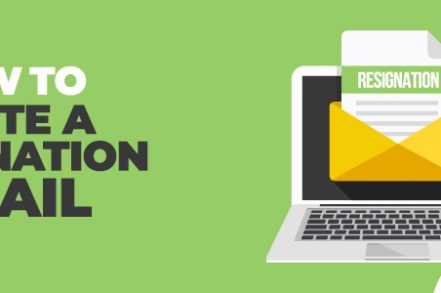If it’s time to move on from your current job, it can be difficult to communicate that to your current employer.
But if you leave with class and style, you can maintain your current working relationships over the long term while you form new ones in your next role.
So in this article let’s break down how to write a resignation email, with several examples and templates you can pull from.
What is a Resignation Email
A resignation email is a formal written email declaring your intention to leave your current position. It typically includes the intended date of your departure as well.
How to Write a Resignation Email (+ Examples)
It’s best to classify each resignation email into 4 key parts:
- Subject Line
- Greeting
- Intro and Body
- Conclusion and Signoff
Let’s look at examples of each section, then in a minute we’ll put it all together with some example templates:
1. Subject Line
Get right to the point in your subject line:
Example: “Notice of Resignation — (name)”
2. Greeting
The simpler the better:
Example: “Dear (name)”
3. Intro and Body
The introduction is the first portion of the body, and should directly address the nature of this email (your resignation). The body can expand on this point and soften the blow, while providing additional details or next steps:
Example: “I’m writing to inform you of my official resignation from (company). I appreciate the opportunity, but I will be accepting a new role. Please advise me of a desired leaving date so we can coordinate my departure smoothly. I wish you and everyone at (current company) well.”
4. Signoff
Your email sign-off doesn’t need to do any heavy lifting. Save that for the body:
Example: “Best regards — (name)”
What Not to Include in a Resignation Email
While it’s important to know what to include in a resignation email, it’s also key to avoid certain things, namely:
- Bad Mouthing: Avoid blaming others in your organization or speaking poorly of anyone. Even if it’s true, it makes you look much less professional.
- Ultimatums: If you are ready to resign, then say that. Avoid pitching ultimatums such as “unless you increase my pay by X I’m gone.”
- Over Explanations: You might be leaving for personal, professional, or other reasons. But ultimately, keep it brief unless pressed.
7 Resignation Email Templates
Now that we’ve covered the general sections and strategies of a resignation email, here are 7 specific templates you can adapt:
1. Resignation Email to Your Employer
If in doubt, use this resignation email. It checks all the boxes we covered above. Considerate your standard, short, sweet template.
“Dear (name),
I’m writing to let you know I am officially resigning from (company). I’ve truly enjoyed the opportunity to work here.
However, I have accepted a new role at (new company). Let’s agree to an official leave date as soon as convenient.
Cheers,
(name)”
2. Quick Resignation Email
This email is for when you’ve already relayed the news in person. No need to beat around the bush, just recap what you discussed.
“Dear (name),
As we discussed, I am resigning from (company) as I have accepted another role.
Please respond so we can discuss a formal leaving date.
Yours sincerely,
(your name)”
3. Email Addressed to Manager
You likely have a deeper relationship with your direct manager, so you can bring some more personality in the mix. It’s not quite the same as messaging the owner of the company (unless of course you have that level of relationship with them as well).
“Hey (name),
Great catching up earlier. Like I said, I’ll be resigning from (company).
Thanks so much for all your support and training throughout my time here.
Hope to keep in touch going forward.
Best,
(name)”
4. Resignation Email Including Notice Period
Always give your employer advanced notice when you can. It shows professionalism and savvy. By giving a notice period, you can always stick to that time frame.
However, they may wish to keep you around longer, or even let you go sooner. Be prepared for your time frame to shift either direction.
“Hi (name),
This email is formal communication that I am leaving (company) in resignation. I will be joining a new company within 2 weeks.
I appreciate the learning experience here, and wish you all the best in your future hiring and endeavors.
Sincerely,
(name)”
5. Resignation Email Addressed to HR
When sending an email to HR, keep it high level and formal. Logistics are the main concern. Your HR team may have formed a relationship with you outside of work contexts.
However, keep in mind you are dealing with a company. At the end of the day, when dealing with hirings, firings, or resignations, HR needs to get down the bottom of things so they can properly perform their job.
“Dear HR team,
I am writing to let you know that I will officially be accepting a new role at (company) and therefore resign from (current company).
Please contact me to arrange an official leaving date at your convenience.
Thank you and best regards,
(name)”
6. Email to the Whole Staff
If you are a manager or communicate with multiple people on the team, then you might want to send a mass email informing them of your decision. After all, those professional relationships might be important later on.
Therefore, be sure to stay formal but also make some personal connections on your way out.
“Hi Everyone,
You might have already heard, but I am leaving (company) effective on (date).
I loved getting to know all of you and working with you. I trust the company will continue to prosper in your hands.
I hope all of you have incredible futures awaiting and I look forward to keeping in touch.
Thanks again!
Cheers,
(name)”
7. Email Giving a Notice Period
When leaving your current position to a new one, it’s common courtesy to give a notice period. You want to balance being fair to your current employer with meeting your own income and career needs.
In this example, you will let them know the date you would ideally leave. However, you leave the date open to negotiation in case they have another preference. This keeps the door open to a long term relationship showing that you aren’t just going to leave abruptly.
“Hey (Name),
I’m sending this email to let you know that I am formally leaving my position as (position) at (company) in resignation. I wanted to provide you with 2 weeks of notice. That way, you can find a suitable replacement.
I would love to begin this process of resignation today. I am glad to work with you to find a better date if you need to alter it. Please reach out as soon as possible so we can reach an agreement.
I have enjoyed working here and wish you the best.
Regards,
(name)”
In Conclusion
Thinking of what to say in your resignation email can be difficult, but it doesn’t have to be. If you follow the examples and templates above, you can get it done in less than an hour. That way, you can get your current employer on the same page as you shift your focus toward your future.
Track emails, email reminders & templates in Gmail for free
Upgrade Gmail with the features it’s missing
Add to GmailDavid Campbell
David Campbell is the editor of the Right Inbox blog. He is passionate about email productivity and getting more done in less time.




